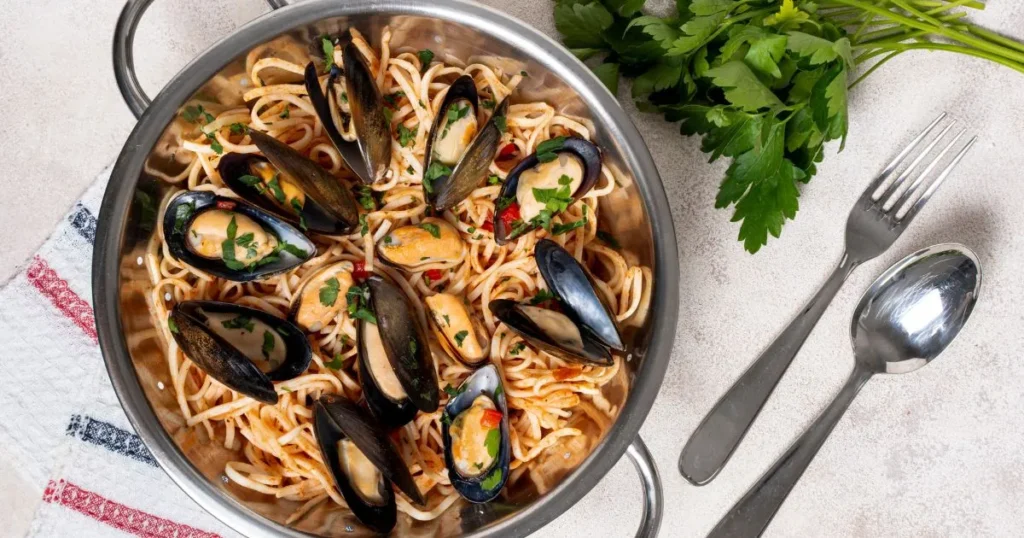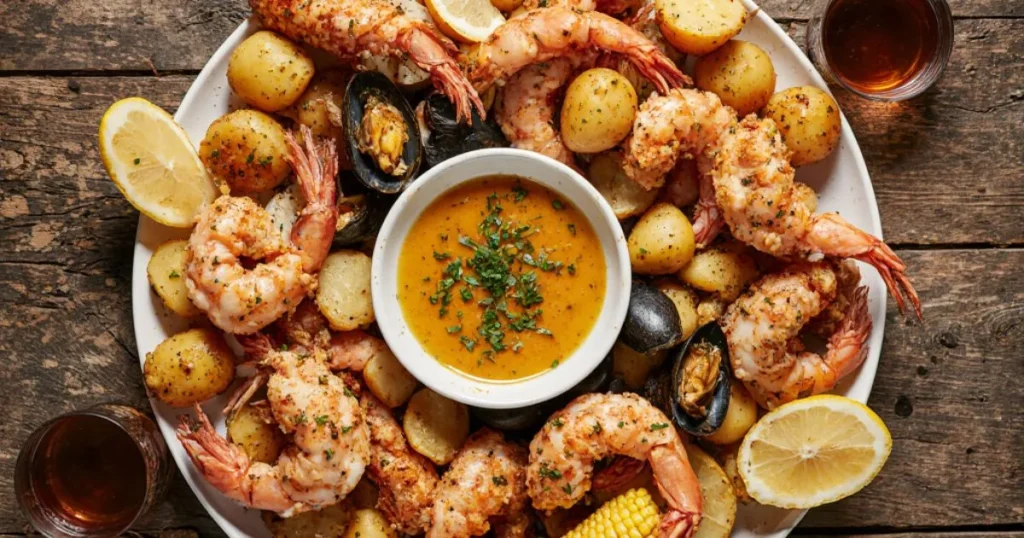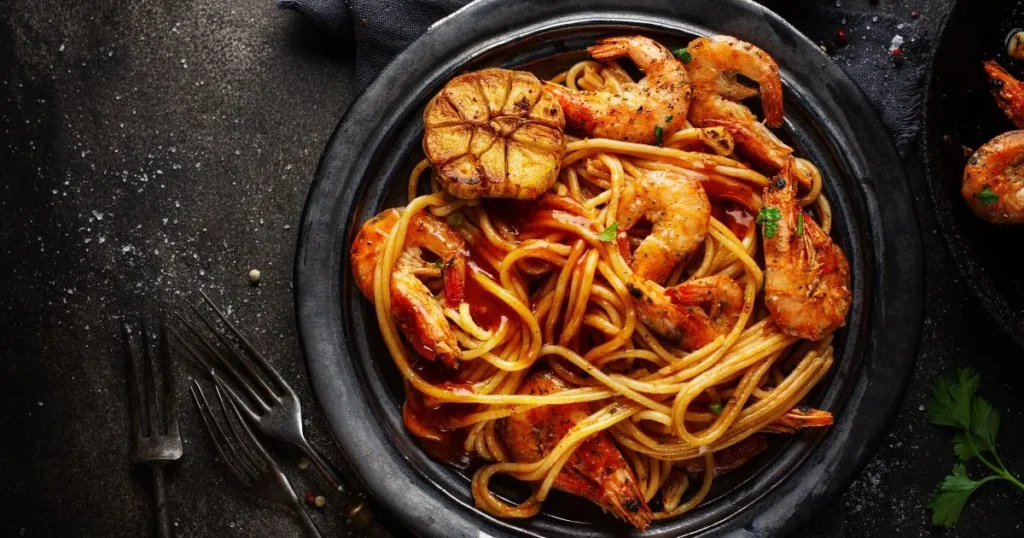Few dishes carry the same inviting warmth and elegance as a well-made seafood casserole. When you take the first spoonful of a bubbling dish layered with creamy sauce, tender seafood, and a golden crust, you’re not just tasting food — you’re savoring a comforting memory. Whether you’re preparing dinner for your family, entertaining guests, or simply treating yourself to something indulgent, a seafood casserole recipe is a versatile way to bring coastal charm straight to your kitchen.
You’ll soon see why these baked seafood creations have become timeless favorites. They’re filling yet refined, and they adapt beautifully to whatever seafood you have on hand. From shrimp and crab to lobster or scallops, every bite reflects the deep, rich flavors of the sea, balanced by creamy textures and baked perfection.
Table of Contents
Why Seafood Casseroles Are the Ultimate Comfort Food
Seafood casseroles offer more than nourishment they bring emotional satisfaction. You probably associate casseroles with family gatherings, holidays, or cozy weekend dinners, and seafood versions elevate that comfort into something truly special.
Nutritional Benefits
Seafood is naturally high in protein, omega-3 fatty acids, and essential nutrients that support heart health and brain function. When you combine these with ingredients like vegetables, whole grains, and dairy, you create a well-rounded dish that’s both comforting and nutritious.
Ease and Versatility
Unlike complex seafood dishes that require precision timing, casseroles are forgiving. You can combine different seafood types, experiment with sauces, and adjust textures without stress. It’s ideal for weeknight dinners because you can prepare it ahead of time, refrigerate it, and bake it when needed.
Perfect for Every Occasion
- Family Dinners: A single casserole can serve a crowd with ease.
- Holidays and Parties: Seafood casseroles add sophistication to the table.
- Meal Prep: Many can be stored and reheated without losing flavor.
You get both convenience and comfort a rare combination in today’s fast-paced world.
Essential Tips for Making the Perfect Baked Seafood Casserole
To achieve the right flavor balance and texture, there are a few essential principles to keep in mind.
Choosing the Right Seafood
The foundation of your casserole starts with the seafood itself. You can use one type or mix several for richer flavor.
Best Options:
- Shrimp — adds sweetness and texture
- Crab — delicate and flaky
- Lobster — luxurious and buttery
- Scallops — mild with a tender bite
- White fish (cod, haddock, halibut) — perfect for layering
Fresh vs. Frozen:
Frozen seafood can be just as good as fresh if properly thawed. Ensure it’s drained and patted dry before mixing to avoid excess moisture.
Sustainability Tip:
Opt for sustainably sourced seafood. Refer to resources like the NOAA Fisheries Guide or Seafood Watch for eco-conscious options.
Building the Creamy Base
The creamy component gives the casserole its signature richness. Traditional versions use heavy cream, cheese, or condensed soups, but you can adapt based on dietary preferences.
Classic Options:
- Heavy cream
- Cream of mushroom or celery soup
- Cream cheese or shredded cheddar
Lighter Alternatives:
- Greek yogurt or low-fat sour cream
- Coconut milk for a dairy-free twist
- A simple roux made with butter, flour, and milk
This base holds everything together, ensuring every bite delivers flavor and comfort.
Adding Texture and Flavor Layers
Your casserole should feel balanced — creamy inside, crisp on top. This contrast makes it satisfying.
Topping Ideas:
- Panko breadcrumbs
- Crushed crackers or cornflakes
- Parmesan or mozzarella cheese for a golden finish
Flavor Boosters:
- Lemon zest for brightness
- Herbs like thyme, parsley, or dill
- Paprika or a pinch of cayenne for warmth
You can personalize your seafood casserole to suit your taste. That flexibility is what makes it timeless.
Comforting and Baked Seafood Casserole Recipe Ideas
Below are several tried-and-true recipes that bring out the best of the sea in comforting, oven-baked form.
1. Classic Shrimp and Crab Casserole
A creamy, traditional favorite that never fails to please.
Ingredients
| Ingredient | Quantity |
|---|---|
| Shrimp (peeled, cooked) | 1 lb |
| Crab meat | ½ lb |
| Cream of mushroom soup | 1 can (10 oz) |
| Cooked rice | 2 cups |
| Shredded cheddar cheese | 1 cup |
| Onion (chopped) | ½ cup |
| Breadcrumbs | ½ cup |
| Butter (melted) | 2 tbsp |
Instructions
- Preheat oven to 375°F (190°C).
- In a large bowl, combine shrimp, crab, soup, rice, cheese, and onion.
- Transfer mixture to a greased baking dish.
- Mix breadcrumbs with butter and sprinkle evenly on top.
- Bake for 25–30 minutes until golden and bubbly.
Why you’ll love it: This recipe delivers a perfect mix of creamy texture and savory seafood flavor. It’s easy to prepare and ideal for both weeknight meals and special dinners.
2. Lobster Mac and Cheese Casserole
This dish redefines comfort food by pairing creamy pasta with tender lobster.
Highlights:
- Cook elbow macaroni until al dente.
- Mix in a sauce made from butter, flour, milk, and shredded cheese.
- Fold in chunks of cooked lobster and transfer to a baking dish.
- Top with panko breadcrumbs and bake until crisp.
Result: A decadent, restaurant-quality seafood casserole recipe that you can enjoy at home.
3. Healthy Mediterranean Seafood Casserole
Light, colorful, and bursting with flavor — perfect for when you want comfort without heaviness.
Ingredients:
- White fish fillets (cod or haddock)
- Cherry tomatoes
- Kalamata olives
- Capers
- Garlic and olive oil
- Lemon slices and basil
Directions:
- Preheat oven to 400°F (200°C).
- Arrange fish, tomatoes, and olives in a baking dish.
- Drizzle with olive oil and season with herbs.
- Bake for 20 minutes until fish flakes easily.
Why it works: You get vibrant Mediterranean flavors in a lighter, heart-healthy form.
4. Southern-Style Baked Shrimp Casserole
This recipe blends Southern comfort with seafood richness.
Ingredients:
- Shrimp
- Bell peppers and onions
- Cajun seasoning
- Cooked rice
- Cream base or roux
Steps:
- Sauté shrimp and vegetables with seasoning.
- Combine with cream base and rice.
- Transfer to a casserole dish and bake at 375°F until bubbly.
Flavor profile: Bold, spicy, and deeply satisfying.
5. Creamy Scallop and Potato Bake
If you appreciate elegance in simplicity, this dish delivers. Layers of scallops and potatoes create a luxurious texture.
Ingredients:
- Scallops
- Thinly sliced potatoes
- Cream
- Garlic and herbs
- Grated cheese
Method:
- Layer potatoes and scallops alternately in a dish.
- Pour over seasoned cream and top with cheese.
- Bake at 350°F for about 45 minutes until tender.
This casserole pairs wonderfully with a green salad or steamed vegetables for balance.
Make-Ahead and Storage Tips
Preparing in Advance
- Assemble your casserole up to 24 hours before baking.
- Store it covered in the refrigerator.
- When ready, bake as usual, adding 5–10 minutes to the cook time.
Freezing and Reheating
- Use airtight, freezer-safe containers.
- Freeze before baking for best texture.
- When reheating, cover loosely with foil to retain moisture.
- Always reheat to an internal temperature of 165°F (74°C) for safety.
This flexibility makes seafood casseroles ideal for busy schedules.
Serving Suggestions for Seafood Casseroles
Presentation and pairing elevate your dish from home-cooked to impressive.
Sides
- Garlic bread or dinner rolls
- Roasted asparagus or green beans
- Simple salads with citrus vinaigrette
Beverage Pairings
- Crisp white wine like Sauvignon Blanc or Pinot Grigio
- Sparkling water with lemon for a light touch
Garnish Ideas
- Fresh parsley or dill
- Shaved Parmesan
- Lemon wedges
Attention to these details enhances both taste and presentation.
Common Mistakes to Avoid
Even experienced cooks sometimes slip up when making seafood casseroles. Avoid these pitfalls for consistently great results.
- Overcooking seafood: Leads to toughness and loss of flavor.
- Excess liquid: Too much sauce or moisture can make the dish soggy.
- Skipping seasoning: Seafood needs balanced seasoning throughout the layers.
- Not pre-cooking rice or pasta: They’ll absorb too much liquid and affect texture.
Keeping these points in mind ensures every casserole turns out perfectly.
FAQs About Seafood Casserole Recipes
What seafood works best in a casserole?
Shrimp, crab, lobster, scallops, and mild white fish all perform beautifully. Mixing varieties enhances texture and taste.
Can I make a seafood casserole without cream?
Yes. You can replace cream with tomato-based sauces, Greek yogurt, or coconut milk for lighter versions.
How long does seafood casserole last in the fridge?
Typically, up to three days when stored in an airtight container and kept refrigerated below 40°F (4°C).
Can I use frozen seafood in a casserole recipe?
Absolutely. Thaw completely, drain, and pat dry to remove excess moisture before adding to your recipe.
Can I add vegetables to my casserole?
Definitely. Spinach, peas, bell peppers, or mushrooms make excellent additions that add flavor and nutrition.
Conclusion: Bringing Comfort and Ocean Flavor to Your Table
When you make a seafood casserole recipe, you’re creating more than just dinner — you’re building an experience of warmth, taste, and togetherness. Each baked dish tells a story of the sea, of comforting moments shared around the table, and of simple ingredients transformed into something extraordinary.
Whether you lean toward rich lobster macaroni or a light Mediterranean bake, the goal remains the same: bringing flavor and comfort to your home.
So, gather your ingredients, preheat your oven, and let your kitchen fill with the irresistible aroma of baked seafood perfection.
Call to Action:
If you enjoyed these ideas, try one of the recipes tonight and share your results with friends or on your favorite food forum. Comfort, after all, is best when shared.


